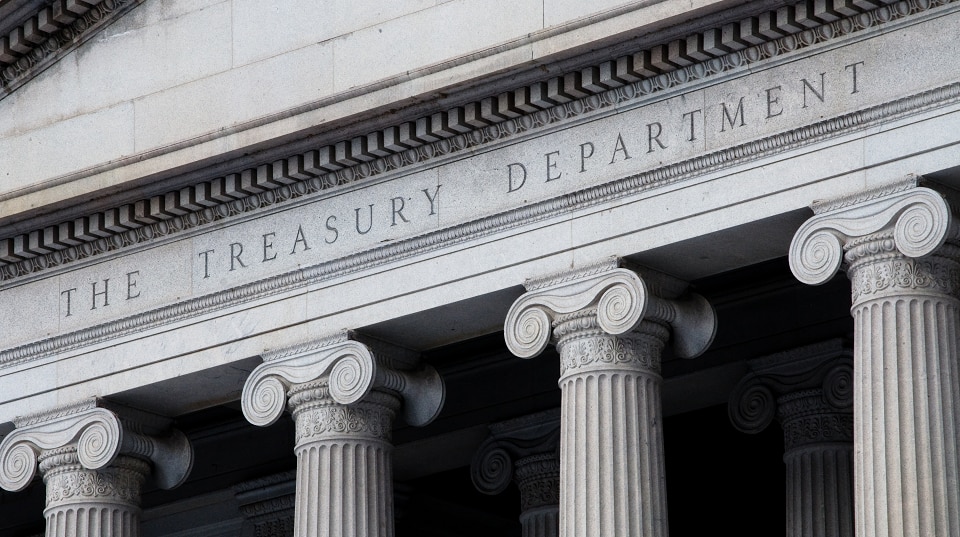by Kathy Jones, Senior Vice President, Head of Fixed Income Strategies, Schwab Center for Financial Research
The new year kicked off with a sharp rise in Treasury bond yields, despite unprecedented political turmoil and signs that the economic recovery is slowing. In the first 10 trading days of the year, 10-year Treasury yields rose sharply, and the yield curve1 steepened to its highest level since 2017—moves that are typically seen when the economy is expanding at a healthy clip. In many ways, it appears that the market is disconnected from the current state of the economy and politics.
Bond yields reflect that the market is focused on the outlook for stronger growth and potential inflation down the road

Source: Bloomberg. Daily data as of 1/11/2021. Past performance is no guarantee of future results.
In our view, the market is looking beyond current conditions and focusing on the future, where prospects suggest stronger growth and potentially higher inflation down the road. While the consensus expectation has been for stronger growth in the second half of 2021, the election results appear to have pulled those expectations forward. With the presidency and majority in Congress held by one party, concerns about gridlock have given way to expectations of a faster recovery, more expansive fiscal policy, and higher inflation. The recent move up in yields may be a bit too much, too soon, but the overall direction in yields is likely to remain higher.
Here are three factors driving bond yields up:
1. The vaccine rollout has boosted optimism.
The pace of the economic recovery depends on the path of the COVID-19 virus and the ability to get it under control. After a slow start, it appears that the pace of vaccine distribution is picking up which has raised hopes for a stronger recovery, even amid a staggering rise in cases. Moreover, the incoming Biden administration has emphasized the need to get the pandemic under control as its top priority. Plans include employing federal resources to help fund a coordinated distribution effort. Anything that speeds up the vaccination process should help boost the economy by making it safer for people to congregate and resume activities that have been shelved.
The service sector2 is likely to benefit the most. Since the onset of the pandemic, jobs in the service sector and in local government have been the biggest contributors to rising unemployment.
Employment by industry, in thousands

Source: U.S. Bureau of Labor Statistics, employment from the current employment statistics survey (National). Monthly data as of December 2020.
Small businesses like bars and restaurants, which have been hit hard by the pandemic, would likely benefit the most from a vaccine, along with the education sector, where resumption of full time in-person schooling would help teachers, janitors, bus drivers and other education-service workers get back to work. Small businesses make up about half of all private-sector employment, and local government accounts for about 12% of all jobs.
December’s weak jobs report will likely increase the urgency in the administration to get the economy fully back on its feet. Although gross domestic product (GDP) growth has recovered about 70% of what was lost since the onset of the COVID-19 crisis, the recovery in job growth has lagged. Moreover, there are signs that it is faltering. The labor force participation rate has flattened out in recent months as more people drop out of the job market.
The labor market recovery is lagging the overall economic recovery

Source: Bureau of Labor Statistics. U.S. Labor Force Participation Rate SA , Labor Force Participation Rate: 25-54 yrs. (Prime Age), monthly data as of 12/31/2020.
Despite these readings, bond yields have continued to move higher, signaling that the market is growing more optimistic about the recovery.
2. Fiscal/monetary policy has provided liquidity.
For much of last year, monetary policy has been the driving force behind the pandemic response. The Federal Reserve cut rates to near zero, expanded its balance sheet, provided liquidity to the global markets, and set up special facilities to channel money to businesses. Consequently, the added liquidity in the global markets aided the recovery in the financial markets, but was less effective in aiding the recovery for many households and businesses. The federal government’s fiscal-policy response was robust in the early months of the crisis, but the impact tapered off as the year went on.
The new administration appears more focused on job growth as a measure of success than stock market performance. Consequently, it’s likely that there will be a push for substantial fiscal stimulus. With a slim majority in Congress, there are expectations that the Biden administration could succeed in getting a fiscal aid package of about $1 trillion passed in the first half of 2021, focused on supporting the areas of the economy that have been the most adversely affected—lower-income households, small businesses, as well as state and local governments.
Janet Yellen, the nominee for Treasury secretary, has already indicated she will focus the department on aid to small businesses. In one of her first tweets since her nomination, Yellen made it clear that small business and job recovery are the priority: “One thing is clear from the jobs report: We need to invest in small businesses. Not only will they be at the center of the recovery, they have been the hardest hit. We recognize that and will provide assistance and focus on the businesses that serve the hardest hit communities,” Yellen wrote.
As the former Fed chair, Yellen is in a particularly strong position to coordinate fiscal policy with monetary policy. As deficit spending rises, Treasury can coordinate the size and maturities of its issuance with the Fed’s purchases for its balance sheet. Under the Fed’s new policy framework, it plans to hold off on rate hikes until the unemployment rate falls and inflation picks up. Market-based readings of inflation expectations have been on the rise since that new framework was adopted last year. In 2021, the combination of expansive fiscal and monetary policies will likely fuel a continued rise in inflation expectations.
3. A weaker U.S. dollar has boosted trade.
A third factor fueling the rise in bond yields is the downtrend in the dollar. On a broad trade-weighted basis, the dollar has fallen by about 15% from its peak level in March. A weaker dollar tends to boost growth by making U.S. exports more competitive and raise inflation by pushing up import prices. Commodity prices, which are largely priced in dollars, tend to rise when the dollar falls—fueling inflation. The recent rise in commodity prices has coincided with the drop in the dollar.
Commodities are one of the key drivers behind the EM currencies

Source: Bloomberg. CRB All Commodities Price Index and the Fed Trade Weighted Dollar Emerging Market Economies Index (CRB CMDT Index, USTWEME Index). Monthly data as of 12/31/2020. Past performance is no guarantee of future results.
A weakening dollar also typically signals that global financial conditions are loose. In other words, there is a large supply of dollars in the global economy to accommodate trade and financial transactions.
Bond yields: How much higher?
While the pace of increase in bond yields has been fast so far this year, it’s not too surprising given that yields were starting at a very low level. In fact, real yields (adjusted for inflation) have been negative for most of the past year. Consequently, there was plenty of room for yields to move up as sentiment changed. The rise in Treasury Inflation-Protected Securities (TIPS) breakeven levels (that is, the inflation level implied by the difference between nominal Treasury yields and TIPS yields) indicates that expectations for inflation have risen very fast and gone very far. However, we see the trend easing up as breakeven levels approach the upper end of the Fed’s tolerance band of 2% to 2.5% for inflation.
Market inflation expectations have been rising

Source: Bloomberg. U.S. Breakeven 10 Year (USGGBE10 Index) and U.S. Breakeven 5 Year (USGGBE05 Index). Daily data as of 1/12/2021.
Moreover, the market appears to have raced ahead quickly in anticipation of a more normal economy, but there are plenty of hurdles in the way. COVID-19 cases are still rising, and mobilizing to distribute the vaccine more broadly will take time. Similarly, many sectors of the economy are still struggling due to falling demand and high debts. Also, there are still more than 9 million fewer people employed now than a year ago. With that much excess capacity in the economy, inflation is likely to remain low for the next year or two despite rising expectations. Our longer-term expectation for 2021 is for 10-year Treasury yields to move up to about 1.6%.
For those reasons, we haven’t changed our outlook or guidance for the fixed income markets in 2021 despite the sharp rise in yields and improving sentiment on the growth outlook. We continue to favor keeping the average duration in bond portfolios on the low side to mitigate the impact of rising rates, and we suggest keeping average credit quality high. If yields move higher, as we anticipate they will this year, we will most likely look at it as an opportunity to buy some longer-term bonds to add income to portfolios.
*****
1 The yield curve is the difference between short-term and longer-term Treasury yields.
2 The service sector, also known as the tertiary sector, is the third tier in the three-sector economy, and encompasses intangible services such as maintenance and repairs, teaching, training and consulting. (The other two sectors are the primary sector, including farming and mining, and the secondary sector, including manufacturing and business activities that facilitate the production of tangible goods.)
Copyright © Schwab Center for Financial Research














